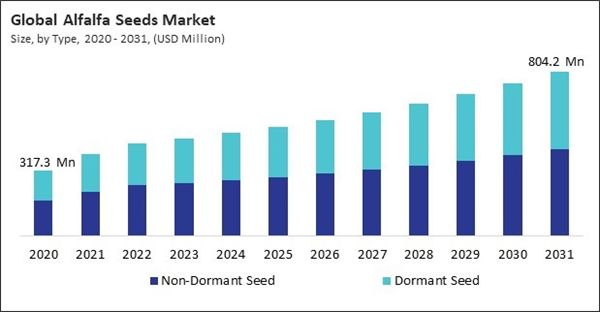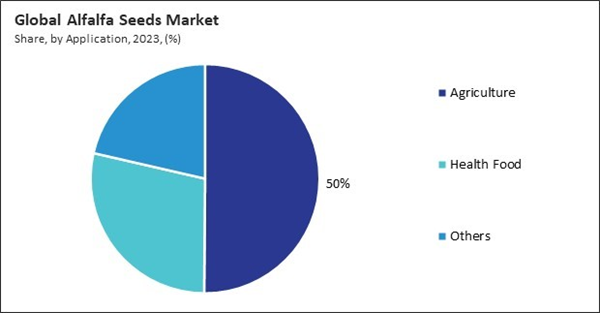Europe’s temperate climate and diverse geographical regions provide favorable growing conditions for alfalfa cultivation. Alfalfa thrives in regions with moderate temperatures, well-drained soils, and sufficient moisture, making it well-suited for production across various states and provinces in the Europe. Thus, the Europe region acquired $187.15 million revenue in 2023. In terms of volume, the Europe region would utilize 16,958.50 Tonnes of alfalfa seeds by 2031. The demand for alfalfa seeds increases as farmers seek to grow alfalfa to meet the feed requirements of their livestock.
Hybrid alfalfa seeds are developed through controlled crossbreeding of genetically distinct parent plants, resulting in offspring with superior traits such as higher yield potential, improved vigor, and uniformity. Farmers are attracted to hybrid varieties for their enhanced productivity, which translates into increased forage production per unit area, higher yields per cutting, and improved economic returns. Hence, the increasing adoption of hybrid seeds drives the market’s growth.
Additionally, Alfalfa is a leguminous crop capable of forming symbiotic relationships with nitrogen-fixing bacteria called rhizobia. Through this symbiosis, alfalfa plants can convert atmospheric nitrogen into a form available for plant uptake, enriching the soil with nitrogen. The biological nitrogen fixation process reduces the need for synthetic nitrogen fertilizers, mitigates nitrogen runoff and leaching, and promotes soil fertility and nutrient cycling. In conclusion, growing awareness of soil health benefits is promoting market growth.
However, Alfalfa cultivation typically requires thorough land preparation to ensure optimal soil conditions for seed germination, establishment, and growth. This may involve land clearing, soil testing, soil amendments, and tillage operations for proper seedbed preparation. The costs associated with land preparation can vary depending on factors such as land size, soil quality, and existing vegetation, contributing to the initial investment burden. Thus, high initial investment is hampering the growth of the market.
Driving and Restraining Factors
Drivers- Increasing Adoption of Hybrid Seeds
- Growing Awareness of Soil Health Benefits
- Expansion Of the Agriculture Sector Worldwide
- High Initial Investment
- Long Establishment Period of Alfalfa Seeds
- Increasing Demand for Livestock Feed
- Ongoing Advancements in Seed Breeding Technologies
- Water Scarcity and Irrigation Challenges
- Pest And Disease Pressure
Application Outlook
Based on application, the market is segmented into agriculture, health food, and others. In 2023, the agriculture segment attained 50.1% revenue share in the market. In terms of volume, the agriculture segment would utilize 23,433.30 Tonnes of alfalfa seeds by 2031. Alfalfa is primarily grown for forage production and is a valuable source of high-quality livestock feed, particularly for dairy cows, beef cattle, and horses. Agriculture, especially livestock farming operations, relies heavily on alfalfa as a nutritious and palatable feed source to support animal health, growth, and productivity.Type Outlook
On the basis of type, the market is segmented into dormant seed and non-dormant seed. In 2023, the dormant seed segment acquired a 45.9% revenue share in the market. Dormant seeds have a longer shelf life. In terms of volume, the dormant seed segment would utilize 22,032.53 Tonnes of alfalfa seeds by 2031. This means they can be stored for longer periods without losing their ability to germinate. Farmers often prefer dormant seeds because they can be confident that a high percentage of the seeds, they plant will successfully grow into alfalfa plants.Regional Outlook
Region-wise, the market is analyzed across North America, Europe, Asia-Pacific, and LAMEA. The Asia Pacific region attained a 21.3% revenue share in the market in 2023. In terms of volume, the Asia Pacific region would utilize 11,344.96 Tonnes of alfalfa seeds by 2031. The Asia-Pacific region is experiencing significant growth in livestock production, driven by increasing populations, rising incomes, and changing dietary preferences. As demand for animal products such as dairy, meat, and eggs continues to grow, there is a corresponding need for high-quality forage to support livestock feeding programs.Recent Strategies Deployed in the Market
- Apr-2024: Bayer AG came into partnership with Alpha BioPesticides Limited, an agriculture research and development company. Under this partnership, the companies will integrate more sustainable, efficient, and effective pest management solutions into agriculture. Additionally, Bayer gains access to pioneering bioinsecticides aimed at arable crops like oilseed rape and cereals.
- Sep-2023: DLF Seeds A/S completed the acquisition of Corteva, Inc., an agricultural chemical and seed company. Through this acquisition, DLF will strengthen its seed business with the Corteva Agriscience alfalfa breeding program, including Corteva’s global alfalfa germplasm and breeding program, the Alforex Seeds® brand name, and trademarks including Hi-Gest® alfalfa technology, Hi-Ton performance alfalfa, Hi-Salt salinity-tolerant alfalfa, and msSuntra® hybrid technology.
- Jul-2023: Syngenta Crop Protection AG launched Tuque ExoGEM, a fungicide. The Tuque ExoGEM is designed to quickly protect turf and last through extreme winter weather. Also, the exoGEM method helps shield SOLATENOL® technology, which is a fancy way of saying a powerful fungus fighter, and fludioxonil, another fungus fighter that sticks to plants, from bad weather.
- Mar-2023: Royal Barenbrug Group signed a definitive agreement to acquire the UK business of Watson Seeds Ltd., a seed specialist. Through this acquisition, Barenburg will further strengthen its presence in the UK and add retail capabilities. Additionally, the acquisition will allow Barenburg Group to integrate Waston Group on farm trials and various observation operations in the UK.
- Feb-2023: S&W Seed Company formed a joint venture with Equilon Enterprises LLC, a company offering refining and transportation services for gasoline and other petroleum goods, namely Vision Bioenergy Oilseeds LLC. Through this joint venture, the companies will develop novel plant genetics for oil seed cover crops as feedstocks for biofuel production. Additionally, the joint venture aims to develop Camelina and other oilseed species from which oil and meat can be extracted for future processing into animal feed, biofuels, and other bioproducts.
List of Key Companies Profiled
- Allied Seed, LLC
- Bayer AG
- S&W Seed Company
- Royal Barenbrug Group
- Nutrien Ltd. (Dyna-Gro Seed)
- Great Basin Seed
- DLF Seeds A/S
- Forage Genetics International, LLC
- The Dow Chemical Company
- Syngenta Crop Protection AG
Market Report Segmentation
By Type (Volume, Tonnes, USD Million, 2020-31)- Non-Dormant Seed
- Dormant Seed
- Agriculture
- Health Food
- Others
- North America
- US
- Canada
- Mexico
- Rest of North America
- Europe
- Germany
- UK
- France
- Russia
- Spain
- Italy
- Rest of Europe
- Asia Pacific
- China
- Japan
- India
- South Korea
- Australia
- Malaysia
- Rest of Asia Pacific
- LAMEA
- Brazil
- Argentina
- UAE
- Saudi Arabia
- South Africa
- Egypt
Table of Contents
Companies Mentioned
- Allied Seed, LLC
- Bayer AG
- S&W Seed Company
- Royal Barenbrug Group
- Nutrien Ltd. (Dyna-Gro Seed)
- Great Basin Seed
- DLF Seeds A/S
- Forage Genetics International, LLC
- The Dow Chemical Company
- Syngenta Crop Protection AG










